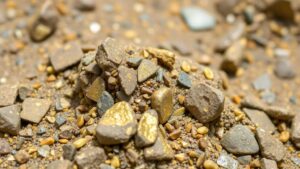How Gold Dredging Was Performed Without Mechanical Equipment in Antiquity
How Gold Dredging Was Performed Without Mechanical Equipment in Antiquity
The practice of gold dredging dates back to ancient civilizations, showcasing human ingenuity in resource extraction. Long before the advent of modern machinery, people utilized simpler methods to retrieve gold from riverbeds and streambeds. This article delves into the techniques, tools, and processes used in antiquity to achieve gold dredging without mechanical equipment.
Historical Context of Gold Dredging
Gold has been a coveted resource since ancient times, symbolizing wealth, power, and beauty. first major gold rushes are believed to have occurred in the regions of ancient Egypt, Mesopotamia, and along the banks of the Nile River. The availability of gold influenced the economic structures of many early civilizations, leading to innovations in extraction methods.
- In ancient Egypt, gold was not only mined but also extracted from river sediments, particularly the Nile, using rudimentary but effective methods.
- In Mesopotamia, early civilizations applied similar practices, emphasizing manual labor and knowledge of local geography.
Techniques for Gold Dredging Without Mechanical Equipment
Golden retrieval methods in antiquity relied on manual labor and simple tools. The most notable techniques included panning, rocker boxes, and sluicing–each with a distinct approach to separate gold from sediment.
Panning
Panning is perhaps the most recognized technique for gold retrieval. It involves the following steps:
- The gold prospector would fill a shallow pan with sediment taken from riverbeds.
- The pan is then submerged in water and shaken, allowing the heavier gold particles to settle at the bottom.
- By tilting the pan, lighter materials are washed away, leaving behind the denser gold.
This method has a deep historical significance. For example, early Roman miners known as the gold diggers employed this practice successfully in rivers like the Rhone and Seine, where they could extract considerable amounts of gold using only wooden pans.
Rocker Boxes
The rocker box was a step up from panning, providing a more efficient method for processing larger amounts of material:
- This device consisted of a rectangular wooden box that was rocked back and forth, creating motion similar to a seesaw.
- Water would flow through the device, allowing dirt, gravel, and gold to be separated.
The rocker box gained popularity during the California Gold Rush of the mid-19th century, demonstrating its enduring utility. Even in earlier periods, such as during the Roman Empire, archeological findings suggest the use of similar technologies for gold mining.
Sluicing
Sluicing is another technique leveraging gravity to separate gold from sediment:
- A sluice box consists of a long, narrow channel that directs water flow through a series of riffles.
- As sediment is washed through, gold particles get trapped behind the riffles due to their higher density and weight.
This method, utilized by both the Incas and the Romans, allowed for consistent gold recovery in riverine environments where gravel and sediment were abundant.
Challenges Faced in Gold Dredging
While these techniques were innovative for their time, they were not without challenges. Some common difficulties included:
- The accessibility of gold-rich rivers, which were often located in remote or rugged terrains.
- The labor-intensive nature of manual techniques, which required significant physical exertion over long periods.
- Environmental factors such as seasonal flooding, which could wash away deposited materials or render mining locations inaccessible.
Real-World Applications and Legacy
The ancient methods of gold dredging have had a lasting impact on modern practices. Elements of panning, sluicing, and rocker technologies continue to be foundational in artisanal mining today, particularly in regions where industrial mining is not feasible.
For example, in parts of Africa and South America, traditional gold panning remains a common livelihood for many, illustrating the persistence of these ancestral methods.
Actionable Takeaways
Understanding the historical context and techniques of gold dredging provides insight into ancient human ingenuity in resource extraction. For individuals interested in gold prospecting today, learning these traditional methods can enhance knowledge and appreciation for gold minings rich history. Also, recognizing the balance between resource extraction and environmental sustainability is vital, as contemporary methods can have lasting impacts on ecosystems.


